After it revolutionized pilots’-watch design with its dashboard-clock-inspired BR 01, one might have expected Bell & Ross to rest on the laurels of that flagship model but the watchmaker did anything but, turning to an array of other onboard aviation devices — from radar screens to altimeters to gyrocompasses, to produce the inventive and exclusive Flight Instrument collection.
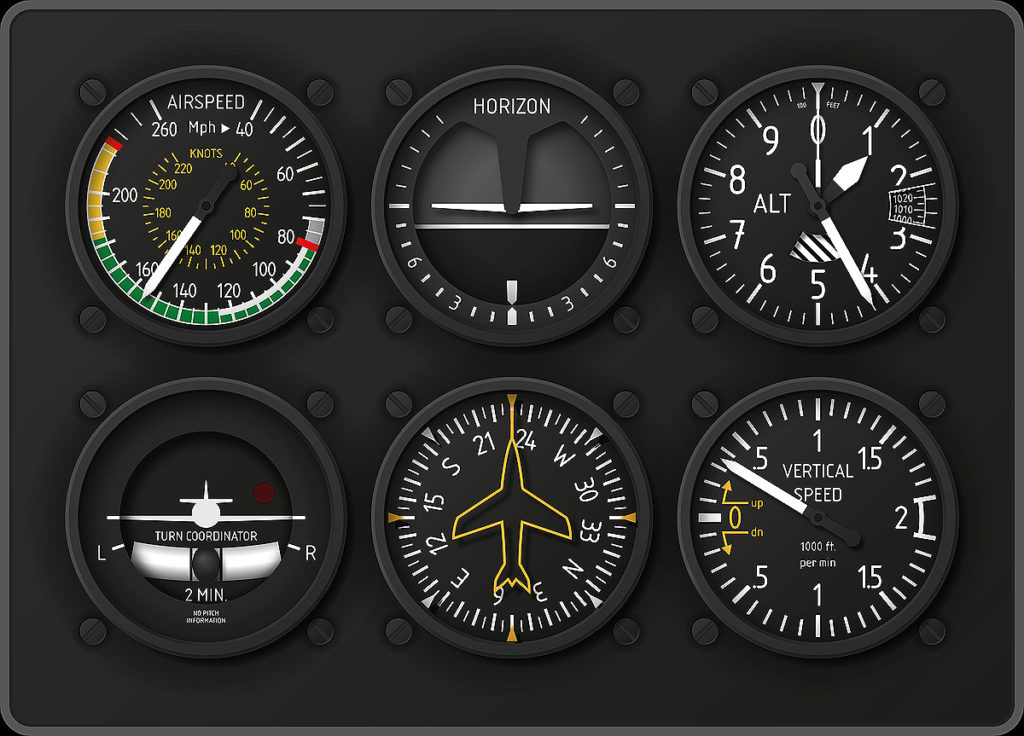
Bell & Ross was founded in 1992 but the watershed moment for its brand identity came in 2005, with the launch of the BR 01 Instrument, a deft translation of an aircraft dashboard clock into a wristwatch. The model established the bold, dark, square-cased aesthetic that has come to define the aviation-influenced watch company, founded by the French duo of Bruno (“Bell”) Belamich and Carlos (“Ross”) Rosillo, ever since. As the BR 01 watch and its various descendants achieved modern icon status in subsequent years, it is now clear that Belamich the designer and Rosillo the businessman were already contemplating what they would do for an encore, and the answer is evident in a series of inventive, idiosyncratic timepieces that have been collectively dubbed the Flight Instrument Collection. Proving that the original BR 01 was anything but a one-trick pony, the watches, which all use the groundbreaking BR 01 as their template, have launched in stages over the past decade, each taking inspiration from a different vital instrument on an aircraft control panel.
“Many watch brands are inspired by aviation,” Rosillo points out, recalling the early days of the BR 01, “but we wanted to take the concept further. When you’re actually wearing the dashboard on the wrist, you’re taking control of the plane; you essentially become part of the plane. We think this made a very strong initial statement. Bruno’s design for the BR 01 was so clean and long-lasting that after the initial idea we thought about revisiting not just the clock but all the other instruments in the cockpit.”
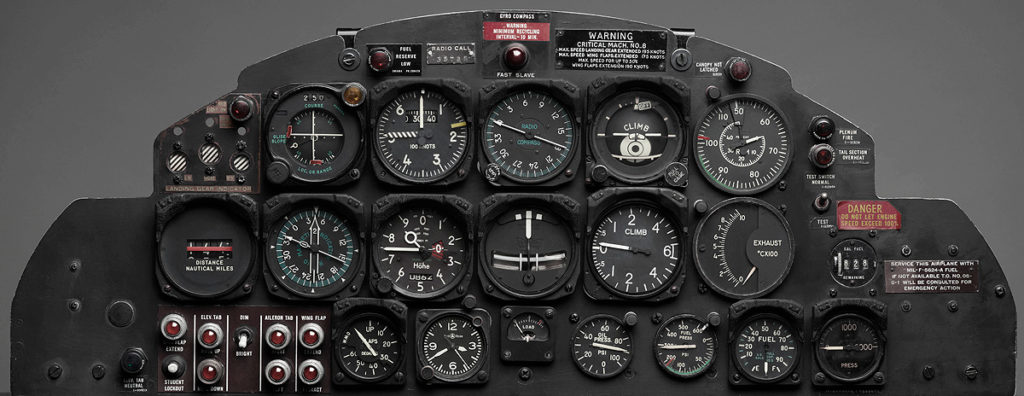
2010-2011: Radar & Red Radar
Bell & Ross’s first foray beyond the dashboard clock to inspire a watch design came in 2010, when it turned to one of the most vital instruments in flight, the onboard radar screen. The original BR 01-92 Radar, a limited edition of 500 pieces, made a splash in the watch community with its cleverly envisioned dial, which used three concentric disks, each marked with a different colored line, in place of traditional hands. The lines on the rotating disks indicated the hour, minute and second on a crosshairs-style concentric scale printed on the underside of the sapphire crystal in a manner that realistically approximated the readout on a radar screen. The first Radar model featured a 46-mm case in the squared BR 01 style in a black DLC-coated case and quickly became a cult hit. Bell & Ross followed it up in 2011 with the BR 01 Red Radar, which offered an even more eye-popping design: its sapphire crystal “radar screen” was now tinted in translucent red. “With the Radar, Bruno took the liberty of having fun,” Rosillo recalls. “We knew we wanted to continue exploring the instrumentation to inspire new watches, but if the Radar hadn’t been a big hit, if it wasn’t successful, we might have not continued. Fortunately it was very successful, and we followed it up with six other limited editions afterward.”

2012: Altimeter, Horizon & Turn Coordinator
The success of the Radar and Red Radar moved Bell & Ross to continue its tour through the cockpit dashboard for watch inspirations and by Baselworld 2012, the brand had no fewer than three new Instrument pieces to unveil to the world, the Altimeter, Horizon and Turn Coordinator.
An altimeter is used to measure altitude based on atmospheric pressure. In an aircraft, it calculates altitude based on reference points such as the ground, the sea, or an isobaric surface. The watch based on this instrument adapts the win- dow at the 3 o’clock position, which displays the atmospheric pressure, into a date indicator, with numerals lining up on two independent disks. Elsewhere on the black dial are the grooved indicator and the traditional “ALT” indication for Altimeter. The hands and indexes, also executed in the style of the dashboard instrument, have a white photoluminescent coating for contrast and the case’s matte black carbon finish is rem-iniscent of the dashboard device.
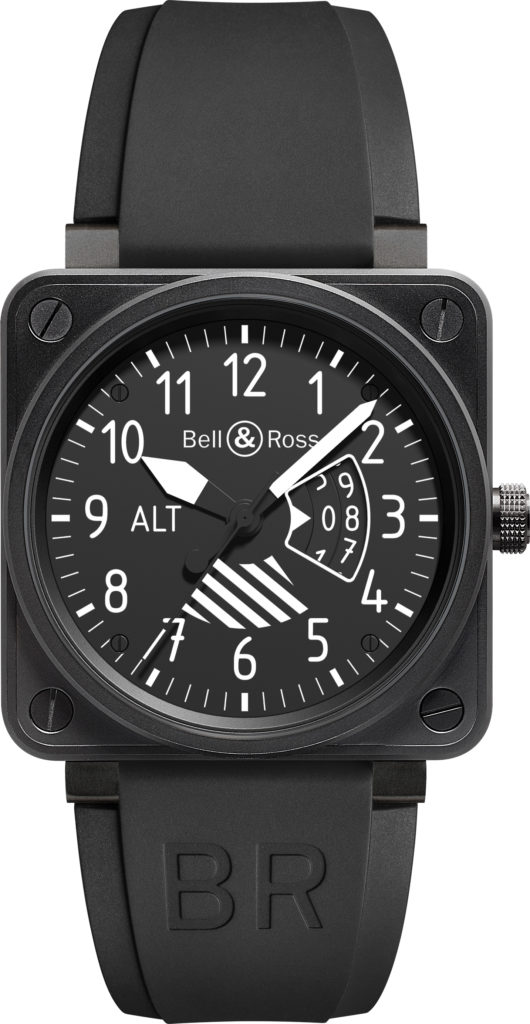
The two-part dial of the Horizon, designed in the spirit of an aircraft altitude indicator, has a grey sector representing the sky and a black one representing the Earth, bisected by a white horizon line marking the 9 o’clock-to-3 o’clock axis. The hour markers are on a raised ring in the foreground for optimal legibility, and a bridge in the shape of the one on the instrument conceals the attachment of the minimalist-look hands, which are in two different shapes and remain legible even when they move below the bridge thanks to a window at 12 o’clock.
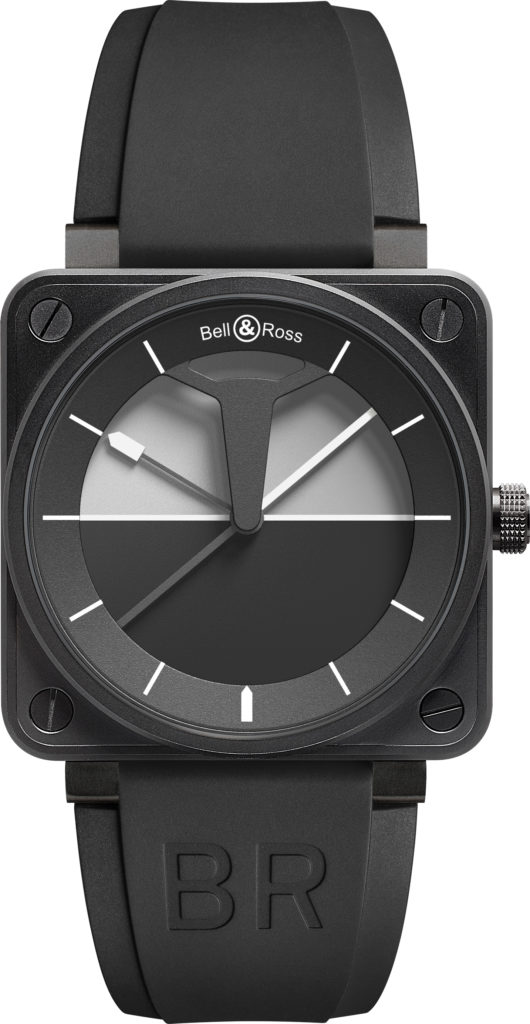
Similarly to the Radar models, the Turn Coordinator has a dial comprised of two independent concentric disks, the outer one graduated to 12 hours, the inner one to 60 minutes. A vertical white marker under the crystal points to the hour and minute on the disks, enabling a reading of the time from top to bottom. Like the dashboard device it emulates, which is used to indicate the rate of turn or rate of change in an aircraft’s heading, the watch features a horizon line in the shape of a plane, separating the top window of the dial, which indicates the time, from the bottom half, which is opaque. Again in the spirit of the Radar models, the disks for the Turn Coordinator needed to be ultra-light to avoid deformation and friction and maintain power reserve. All three of the 2012 Flight Instrument pieces were limited to 999 pieces and based their clever timekeeping displays on ETA base calibers — the ETA 2892 for the Horizon and Turn Coordinator, the 2896 for the Altimeter.
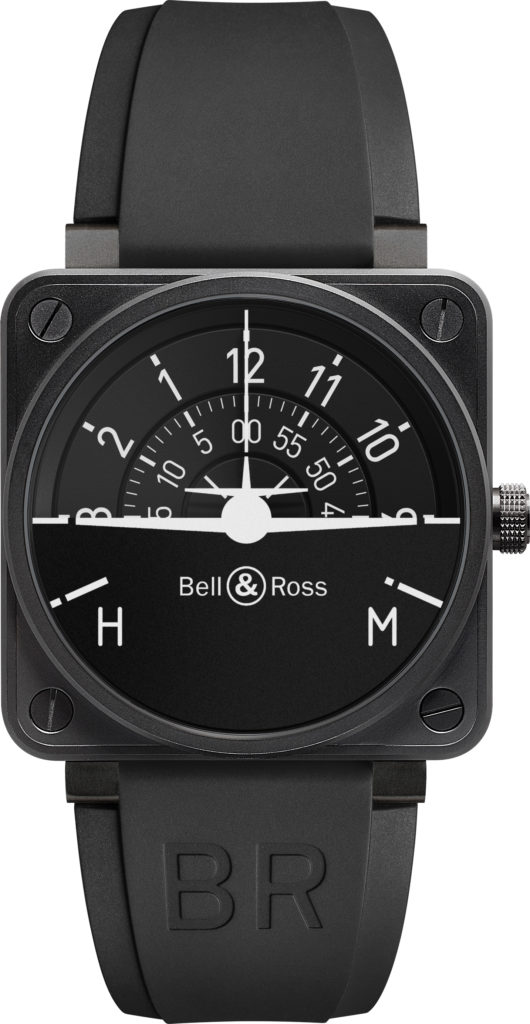
2013: Airspeed, Climb & Heading Indicator
Another trifecta of Flight Instrument limited editions followed in 2013. The BR 01-92 Airspeed takes its cues from the anemometer, which measures an aircraft’s speed in relation to the air in which it is moving. The BR 01-97 Climb is inspired by an instrument called the variometer or vertical speed indicator, which uses atmospheric pressure to measure whether a plane is ascending, descending or in level flight. And the BR 01-92 Heading Indicator is based on a device called a gyrocompass (sometimes referred to as a course or heading indicator), which indicates an aircraft’s course during both manual flying and autopilot.
The BR 01-92 Airspeed borrows the graphic characteristics of an anemometer for its unconventional time display. Echoing the arrangement of elements on the original instrument, the hour, minute and second graduations are separated to promote the minutes on the main dial while the hours are displayed in the center. The three colors that indicate levels of criticality on a cockpit anemometer — green, white and yellow — appear on the outer ring of the dial and indicate the zones by quarter-hours. The hands and indexes have a white photoluminescent coating.
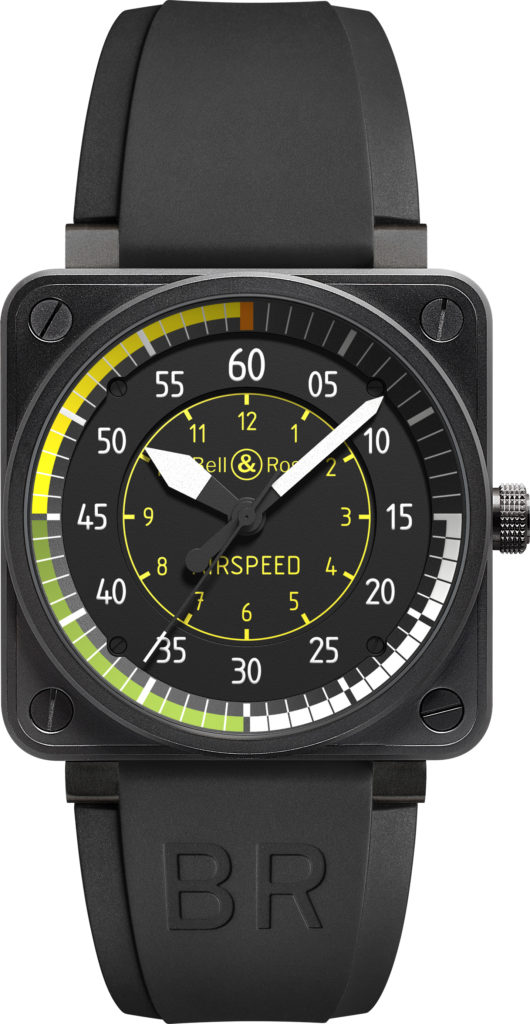
The BR 01-97 Climb echoes the design of a variometer chiefly with its unique power-reserve indicator, which replaces the indication of vertical speed on the original device. This indicator is yellow, contrasting with the black dial and standing out from the white numerals and indices. The date is displayed in a window at 3 o’clock. The typeface used for the “Up” and “Down” matches that on the instrument that inspired the dial. Since a variometer uses only a single, white hand, the hour hand was darkened, helping the dial to more closely resemble the instrument, while the other hands and numerals are photoluminescent.
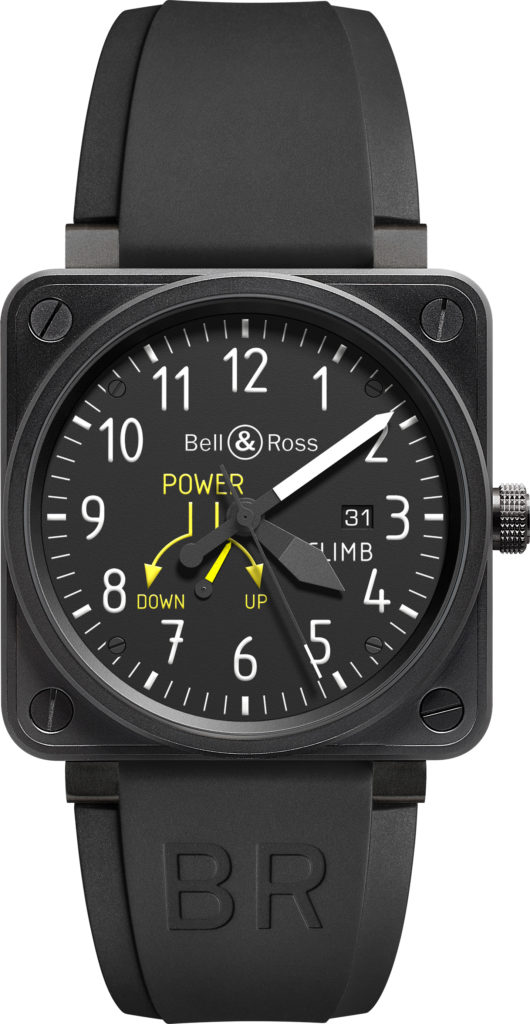
The dial of the Heading Indicator is made up of three independent, concentric disks, graduated for the hours and minutes. The hour indicator, a yellow triangle pointer, is on the outer disk, and the minutes are indicated on the middle disk. The seconds disk in the center is not graduated and features a yellow hand. As on the gyrocompass, the indications W, E and S (for West, East and South) are also on the outer disk, while the N (for North) indication has been replaced by the yellow triangle that points to the hours. Another element from the original instrument, a yellow outline of an airplane, is engraved under the crystal, along with yellow hour indexes. Since each disk weighs 30 times more than a watch hand, they needed to be extra-light in order to reduce neither the power reserve nor the accuracy of the watch, while still needing to be strong enough to avoid deformation and friction. To accomplish this, Bell & Ross’s designers had to develop special materials and new techniques. As they rotate, an adjustment to the nearest micron ensures that the disks are constantly parallel.

Like their predecessors, all of the 2013 models use 46-mm steel cases with a black carbon PVD finish, water-resistant to 100 meters. The Heading Indicator and Airspeed are powered by ETA 2892 automatic movements; the BR 01- 97 Climb, with its power-reserve and date functions, contains an ETA 2897. All are on straps made of rubber and heavy-duty synthetic fabric and limited to 999 pieces; the first 99 of each were released as part of an exclusive collectors’ box containing all six models from 2012 and 2013 and resembling an aircraft control panel.
2019-2020: Bi-Compass, H.U.D.
Despite the compilation of the six Flight Instrument models into a definitive collection, Bell & Ross was not quite finished adding to that collection and revisited the cockpit dashboard for new inspirations in 2019. With a design based on a vintage radio compass, the dial of the BR 03-92 Bi-Compass is arranged as three concentric circles, the innermost a rotating hour disk with a triangular pointer coated with sea-foam-colored luminous paint. The pointer indicates the hour on the Arabic numerals and indices that occupy the middle zone, also treated with blue-green lume. The outer circle, elevated from the others by a steep rehaut, features numerals and indexes for the minutes, indicated by a central minutes hand; both the hand and indices have a contrasting cream-colored luminous treatment. A color-matched date window appears at 4:30. Bell & Ross based the case’s color scheme on the one used on U.S. Navy avionic instruments; it also made the case, in matte black ceramic, a bit more modest than those of previous Flight Instrument watches — the 42-mm size of the brand’s BR 03 models rather than the 46-mm of the BR 01. Inside it beats the automatic BR-CAL.302, based not on an ETA movement this time but on a Sellita SW 300-1, holding a 38-hour power reserve.
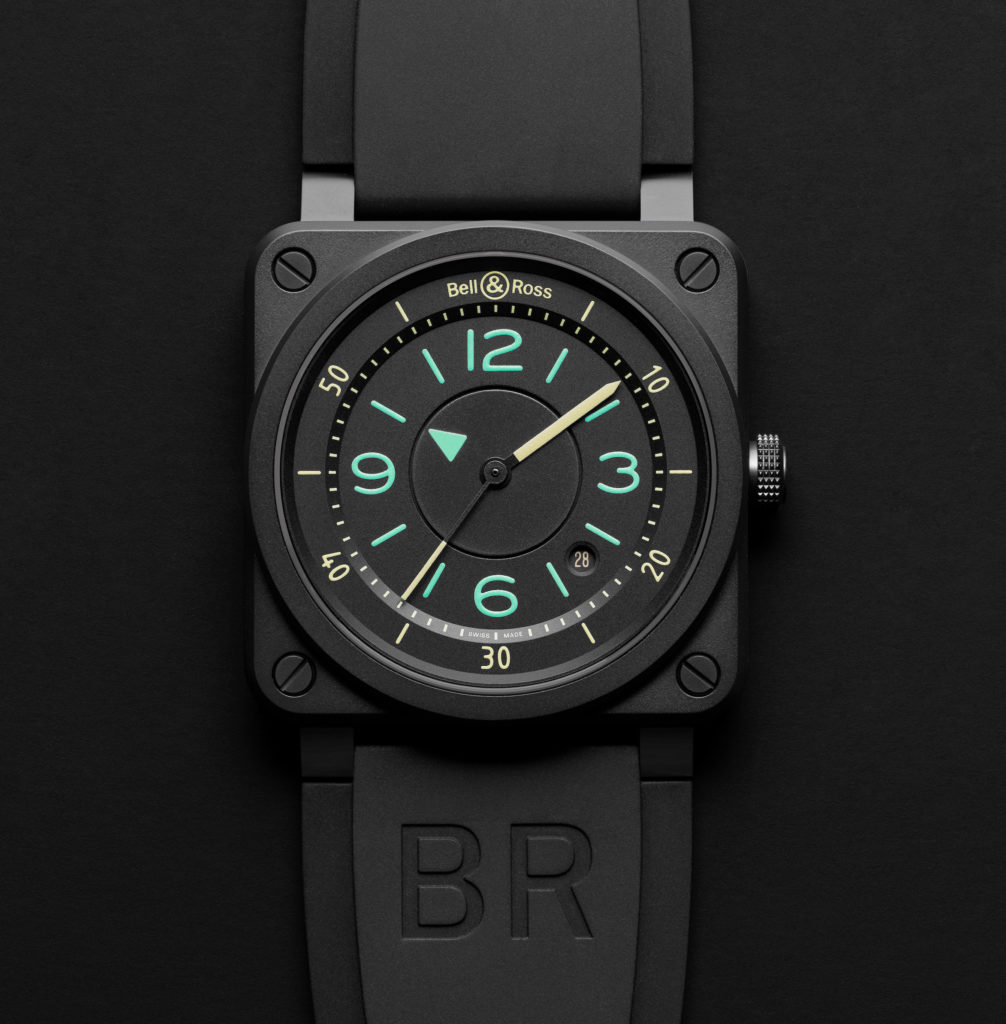
The follow-up, and the model that Bell & Ross declared as “completing” the Flight Instruments family, was another riff on the BR 03, also containing the Sellita-based caliber, the BR 03-92 H.U.D. The initials stand for “Heads Up Display,” the transparent glass windshield in a plane’s cockpit that displays essential data in a digital form within a pilot’s visual field — the aim being to keep the pilot informed while still keeping his or her focus on the target ahead with minimal distraction. The technology, which began with the military in the 1950s, has since been adopted for civil aviation as well as for the automobile industry. The watch, housed in a square case made of matte black ceramic and measuring 42 mm in diameter, re-creates this high-tech screen on its three-layer dial.
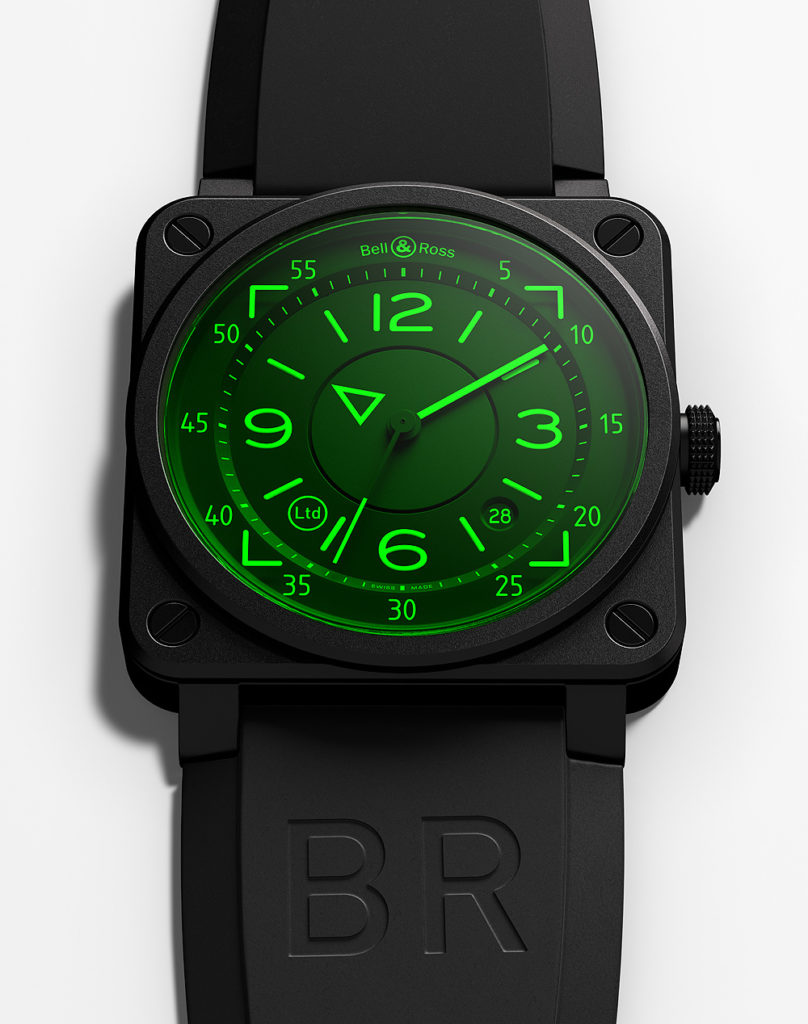
On the top layer, the green-tinted sapphire crystal features four brackets at the corners, printed on the underside and luminous-coat- ed, representing the H.U.D.’s line-of-sight frame. The minutes and seconds hands occupy the middle level, with their central parts purposefully hidden to emulate the digital displays on the instrument panel. At the base level is the main dial, with a triangular marker to indicate the hours, and hour and minute numerals and indexes on concentric scales, all glowing bright green thanks to an application of Super-LumiNova C3. The green color, contrasted against the matte black, re-creates the graphic display of the H.U.D. indicator. The watch is mounted on a black rubber strap with a black PVD-coated steel pin buckle and includes an additional NATO strap made of ultra- resilient synthetic fabric.
2021: Red Radar Ceramic
Most recently, Bell & Ross returned to the quirky model that ushered in the Flight Instrument collection, the Radar. Like the first Red Radar from 2011, the dial of 2021’s Red Radar Ceramic reproduces the scanning motion of a light beam on an onboard radar screen. Rotating under a translucent red sapphire crystal are two ultra-light, concentric disks that replace conventional hour and minute hands. In a major update from the early models, however, these disks now host two miniature screen-printed planes — a passenger plane on the larger outermost disk for the hours, a fighter plane on the smaller disk nearer the center for the minutes — rather than simple colored lines. Like the real-life aircraft they represent, the two planes travel at different speeds: the larger one circling the dial every 12 hours, the smaller one every 60 minutes. The hours scale is printed on the underside of the sapphire crystal, and a slim, red-painted central analog hand laps the concentric disks, which are arranged on two levels, to record the seconds and complete the realistic approximation of a radar screen.
In another departure from the original Radar models, and from most other Flight Instruments, the new watch’s 42-mm case is made of matte-black ceramic, a high-tech material lauded for its light weight and impressive scratch-resistance. Its square case contains the automatic, Sellita-based Caliber BR-CAL.302, which can be found within many models in the larger BR 03 series. Like its predecessors in the Flight Instrument collection, the BR 03-92 Red Radar Ceramic is limited in production — just 999 pieces — and comes with both a black rubber strap and an additional strap made of ultra- resilient black synthetic fabric, both with pin buckle closures made of black PVD-coated steel.
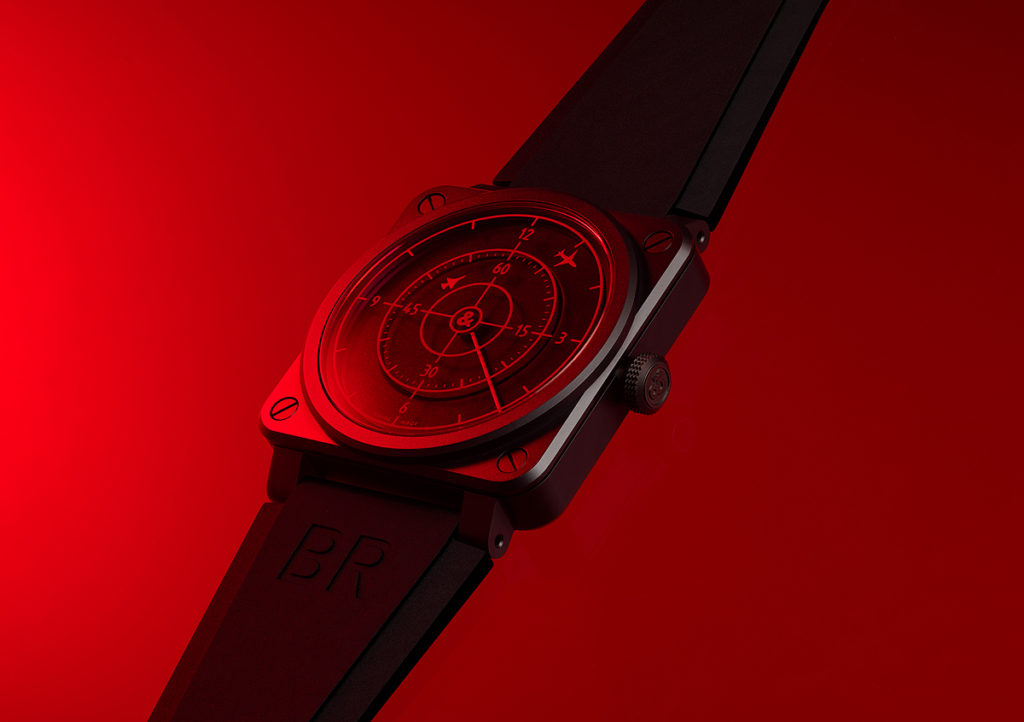
Might the Red Radar Ceramic, with its more modern case and more legible (albeit still unusual) time display, presage new and upgraded versions of other Flight Instrument models? It’s too early to tell, but history has shown that it’s unwise to underestimate Bell & Ross’s founders and their penchant for creative experimentation. “The beauty of the watch industry,” Rosillo reminds us, “is that techniques and technologies evolve.”
–



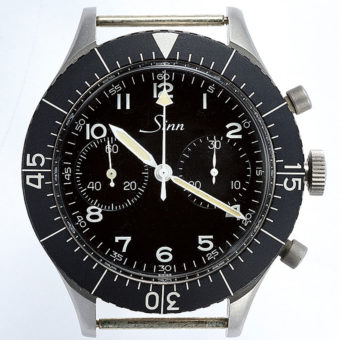



Wondering why they suddenly focused on 42mm from the original 46mm? Any idea?